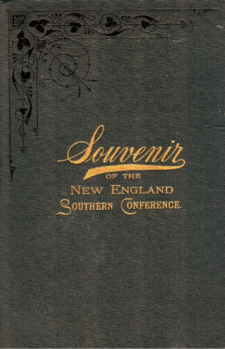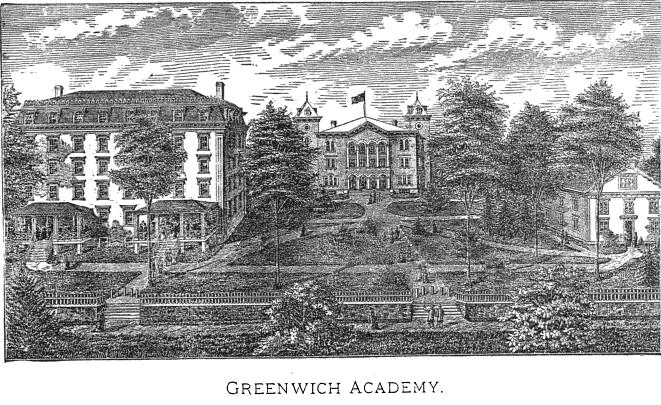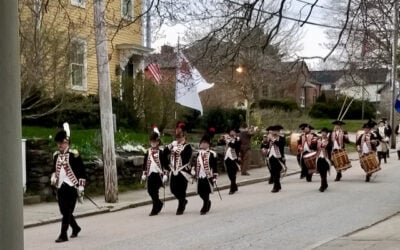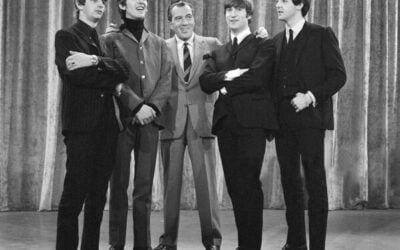By Donald Tunnicliff Rice
 In 1897 the Rev. Rennetts C. Miller compiled, edited, and published a three-volume history of the New England Southern Conference of the Methodist Episcopal Church. The Conference encompassed the eastern half of Connecticut, all of Rhode Island, and the southeastern portion of Massachusetts. Within this area were 190 individual churches, each of which was allotted three or more pages to relate their histories along with photos of church buildings and members of the current officiary. In addition there were essays of general interest including an unsigned piece* on the East Greenwich Academy, at that time under the joint control of the entire conference.
In 1897 the Rev. Rennetts C. Miller compiled, edited, and published a three-volume history of the New England Southern Conference of the Methodist Episcopal Church. The Conference encompassed the eastern half of Connecticut, all of Rhode Island, and the southeastern portion of Massachusetts. Within this area were 190 individual churches, each of which was allotted three or more pages to relate their histories along with photos of church buildings and members of the current officiary. In addition there were essays of general interest including an unsigned piece* on the East Greenwich Academy, at that time under the joint control of the entire conference.
Here is an abridged version:
This institution was established in its present location in East Greenwich in the year 1802, as the Kent Academy. It was the second school of the kind in the state, and has continued to the present time without interruption for a single year.
The buildings are on an eminence on the western shore of Narragansett Bay, and the location is of surpassing beauty, presenting a view of both shores of the bay for a distance of twenty miles or more. From the Academy building may be seen with the naked eye the cities of Providence, Fall River, Warren, Bristol and Newport. Many persons who have visited Europe pronounce the view from the institution equal to that of the bay of Naples. The Academy grounds contain five acres, giving a large campus and a lawn beautifully laid out and ornamented with trees and shrubbery. In the centre of these grounds stands the Academy building proper, one of the finest structures of its kind, erected in 1858. It contains a very superior chapel, commodious recitation rooms, art room, rooms for literary societies, offices, cabinet, laboratory, library and reading room. The Boarding Hall was erected in 1846, and in 1868 it was remodeled and enlarged at a cost of about $15,000. In the early morning of August 11th, 1896, this building, with its contents, was totally destroyed by fire. Since then it has been necessary to supplement the other dormitory accommodations by cottages. A new one of eighteen rooms and all modern conveniences was opened to students September 14, 1897. This fronts on Church Street. An elegant new dining-room and kitchen have been provided in the basement of the Academy building. The present arrangement, with better rooms and new furniture, gives more comfortable quarters than those in the burned structure. The third building, a private residence, situated on the north side of the Academy grounds, now known as the Winsor House, and used as a dormitory by teachers and students, was purchased by the institution in 1856.
Across the street from the Boarding Hall is the Principal’s residence, acquired in 1888, with convenient and elegant parlors for use in the social life of the school. All these buildings are heated with steam and lighted by electricity.
The design of the school is to furnish the best possible facilities for a thorough culture, under religious influences, in all departments of academic instruction. The institution has a library; and the members of the school have access also to the excellent free library of the town, of which the Principal is president, a few rods distant from the Academy grounds. The geological and mineralogical cabinet embraces about three thousand specimens, and is rarely surpassed in variety and completeness. It has recently been completely reorganized. The specimens were all newly labelled and arranged under the direction of a Russian expert, for practical use in the classes of geology, mineralogy, etc. A number of fine specimens of silver and gold ore from the Rocky Mountains, over fifty typical specimens of valuable minerals, fossil remains and geological formations from Kansas and various marbles from New England, are among recent accessions.
The institution has a good philosophical and chemical apparatus; a superior stereopticon; a set of English astronomical slides, showing the various real and apparent motions of the heavenly bodies; a fine collection of Levy’s lantern views; an electric machine, with a twenty-four inch plate; Wightman’s gasometers, and a new compound microscope.
The “Philognothian” and the “Adelphian” societies of gentlemen, and the “Aletheon,” a society of ladies, hold stated meetings for discussions and other literary exercises.
A large and well-conducted reading room is supplied with the most valuable and popular papers and periodicals from various portions of the country.
The first conservatory of music in America was opened here in 1859 by the late Eben Tourjée, director of the New England Conservatory of Music, Boston. No academy in the country has been more widely celebrated for the superiority of its musical department. Pupils are here placed under the same systematic drill and receive for the most part the same studies which would be given them in the best conservatories of Europe.
There is also a commercial college connected with the academy, and a department of stenography and typewriting; also an art department. A normal department was opened in 1888, which has trained several now successful teachers. Particular attention is also paid to elocution. The college preparatory department ranks among the first in New England.
The institution has exerted an important influence in the educational work of the state, a large proportion of its public school teachers having been educated here. Its alumni are found in prominent positions in business life and official stations.
* The article, though unsigned, is an updated version of a nearly identical piece printed in J.R. Cole’s History of Washington and Kent Counties, Rhode Island, published eight years earlier. I find it hard to believe that a prominent Methodist minister such as the Rev. Miller would knowingly engage in intellectual property theft by reprinting copyrighted material without permission. Cole, for his part, expressed his gratitude to his many contributors, but didn’t identify the source of the piece on the Academy. I think it possible that both editors copied from the same source, perhaps a promotional piece published by the Academy itself.

East Greenwich Students and Faculty in June 1897.
GLOSSARY
Adelphian. From the Greek meaning brotherhood.
Aletheon. From the Greek meaning true.
Boarding Hall. A dormitory where meals are also provided.
Cabinet. Any part of a building set apart for the conservation of art, antiquities, etc.
Conservatory. A place of instruction and training in a particular science or art.
Corporator. A member of a corporation.
Electrical Machine. An apparatus for producing electricity in sufficient quantities to perform various experiments.
Elocution. The art which teaches the proper use of the voice, gesture, etc. in public speaking.
Gasometer. An apparatus intended to measure, collect, preserve, or mix different gases
Normal Department. One meaning of normal in those days meant “intending to set the standard as in normal school,” where future teachers were instructed in the principles and practice of their profession.
Philognothian. From the Greek meaning love of learning.
Philosophical and Chemical Apparatus. What we call physics today was referred to as natural philosophy in the nineteenth century. Various instruments were devised to demonstrate various principles of matter, motion, mechanics, hydraulics, pneumatics, electricity, and so on.
Preceptress. A female instructor.
Preparatory Department. There were at that time, as there are today, schools specifically designed to prepare students to enter college.
Rod. A measure of length equal to 5-1/2 yards, or 16-1/2 feet.
Stenography. The rapidly disappearing art of writing in brief signs which represent sounds and words.
Sources: The Century Dictionary: An Encyclopedic Lexicon of the English Language, 1899, and Liddell and Scott’s Greek-English Lexicon, 1894.
Donald Tunnicliff Rice grew up in East Greenwich. He is a freelance writer based in Columbus, Ohio. His latest book is “Who Made George Washington’s Uniform?”






 Subscribe
Subscribe
Outstanding article. Too bad that we can not still enjoy the view described in this article.
This is a treasure. My EGHS Class of 1960 was the last eighth grade class to attend the Academy, and we had our eighth grade graduation at the Swift Gym. The following year we all went to the “new” EGHS on Cedar Avenue, and the Academy buildings were empty. I remember classes in the first two stories of the main building, and music classes in Eastman Hall across the way. Interesting the the Academy was once home to a real Conservatory. I didn’t know Donald Rice, but our paths must have crossed during that year. His brother Cliff was an EGHS ’60 classmate.
Nice article. Living in Winsor Hall with the Brackley’s and others gave me a chance to get in trouble all over the campus.
Would love to know what the tuition and boarding costs were in 1856.
In his biography “Titian” on J.D. Rockefeller, Chernow gives a mention, “shoutout” to the Academy.
I normally footnote my books but must have missed that one as a distant relative if I recall attended for a brief time. I don’t think it was a relation to the Aldrich family. Very prestigious institution. Now the gymnasium is some type of center where even the basketball hoops/backboards have been removed. It was used one time as a place where the kids during the summer could go play basketball, softball, cards, ping pong, badminton, an assortment of competitive games. Occasionally a bus would take them to Gordon’s pond in Warwick to swim. During the winter when the outdoor court would freeze it’d be used as a skating rink.
Men’s softball would be played on the baseball diamond. Urban legend has it that Father Coleman parked a ball from home plate to the top of the gymnasium.
*An addendum or correction US Congressman/US Senator Aldrich’s Alma Mater was EG Academy.
There have been many prominent alumni of the Academy. Here are some of them:
Nelson W. Aldrich, U.S. Senator, Rhode Island
William Daniel Brayton, U.S. Representative, Rhode Island
Marietta Stanley Case, temperance advocate
Mary H. Gray Clarke, correspondent
Isaac T. Goodnow, co-founder of the town of Manhattan, Kansas, and the school that became known as Kansas State University.
Albert C. Greene, U.S. Senator, Rhode Island
George Washington Greene, professor at Brown University
Charles Matteson, Justice of the R.I. Supreme Court
Charles Phelps, first Connecticut attorney general
Harry A. Richardson, U.S. Senator, Delaware
Raymond S. Thatcher, Connecticut State Comptroller
Pardon Elisha Tillinghast, Justice of the R.I. Supreme Court
S. F. Upham, professor at Drew Theological Seminary
William F. Warren, president of Boston University
Alonzo Williams, professor at Brown University
I wish we could still see these buildings today!